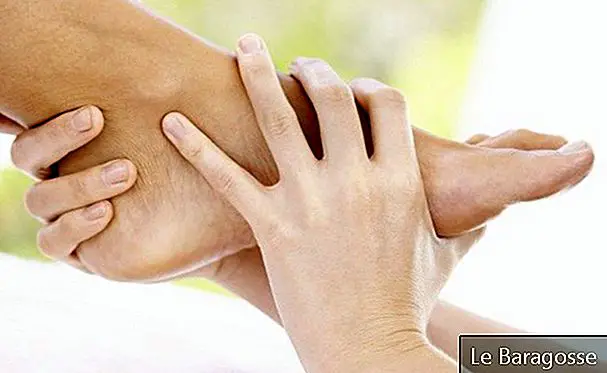
Reflexology originated in China some 5,000 years ago, although there are no documents to prove the exact date, as much has been lost throughout the history of Chinese medicine.
Alline Pereira Camacho, a Corsica Studio professional, a naturopath and a massage therapist graduated from Humaniversity, comments that reflexology means, in short, the projection of the body, of the whole "part", of the macro over the micro.
It is a simple and natural, noninvasive therapy that aims to stimulate the body's internal healing forces, providing physical, mental and emotional well-being.
Reflexology works with the basic proposition that by stimulating some points located on the feet, hands, ears or face, it is possible to help the body to combat different types of physical and emotional problems.
To illustrate: In reflexology, it is believed that if a point (for example, toes) hurts, there is some problem with the organ it represents (whether physical or emotional).
Each point of the feet represents an area of the body. Be it at your fingertips, sole, chest? And can these points be used for the body to eliminate existing toxins and relieve pain? Exemplifies Crystal Hair beautician Denise Finamori.
Reflexology step by step
Although foot reflexology is best known, there is also hand, ear, and face reflexology, for example, with points corresponding to each organ, gland, and body structure.
Is this phenomenon of macro projection on the micro found in different areas of the body? On hands, others on feet, ears (ear), eye iris, spine, skull and tongue. Are the extremities most used in massage because of the ease of locating the points, easy access and the greater number of energy points also used in acupuncture ?, explains Alline.
Reflexology in the hands
Below, Alline explains a brief step-by-step how reflexology is usually done:
- Using a sliding cream and caress the hand with deep touches noticing painful points or small points of tension.
- Detected, check the map to find the corresponding point.
- Press holding this point on the edge of pain along with deeper breathing.
- As soon as the pain relieves, change stitches until you complete the whole hand.

Foot reflexology
Alline explains that the method is the same as for hands:
- Use a sliding cream and caress the foot with deep touches, noticing painful points or small points of tension.
- Detected, check the map to find the corresponding point.
- Press holding this point on the edge of pain along with deeper breathing.
- As soon as the pain relieves, change stitches until you complete the entire foot.

Reflexology in the ears
Check out a basic step-by-step on how ear refloxology is done:
- Massage the lobe well until it looks hot;
- Raise thumb and forefinger, massaging around ear;
- Continue the movement by gently pacing all over the ear, reaching all regions and organs.

Reflexology on the face
The walkthrough is simple:
- Use a cream / sliding oil;
- Make circular movements with your fingertips at the desired specific points (checked on the map) for about one minute.
- Although you are not experiencing pain in some part, you can massage all points slowly to provide relief, well-being and overall improvement of the immune system.
In this video you see an example of facial refloxology. Check out on the map what are the points touched by facial reflexology:

Reflexology Benefits
Denise says the benefits of reflexology are numerous. The main advantages of the technique can be cited:
- Relief of back pain and general pain;
- Stress reduction;
- Relaxation;
- Stimulation of blood circulation;
- Immune system stimulation;
- Release of toxins from the body;
- Emotional Harmonization.
It is worth remembering that reflexology has as its main objective to prevent and assist the treatment of body dysfunction through pressure in the reflex zones of the feet, hands, ears or face.
Reflexology indications

Reflexology offers good results in several cases. "It is indicated for cases of local pain, neck and back pain, constipation, and unbalanced emotional states such as anxiety, stress and anger," exemplifies Alline.
It is worth mentioning that it can be used as a complementary therapy, helping in the treatment of various diseases, as well as relieving pain and tensions arising from everyday life.
Thus, reflexology is commonly used in the following cases:
Pains
- Headache and migraine;
- Back pain;
- Muscle pain;
- Sciatic nerve pain;
- Torticollis;
- Sore throat;
- Stomach ache.
Inflammatory diseases
- Sinusitis;
- Rhinitis;
- Cystitis;
- Tonsillitis.
Gynecological Dysfunctions
- Polycystic ovary syndrome;
- Premenstrual tension;
- Menstrual cramps;
- Sexual impotence;
- Menopause.
Gastrointestinal Diseases
- Intestinal constipation;
- Heartburn;
- Indigestion;
- Gastritis;
- Hemorrhoid.
Emotional problems
- Depression;
- Anxiety;
- Insomnia.
Reflexology contraindications
According to Alline, the main contraindications are:
- Injuries in the region to be worked;
- Advanced diabetes;
- Pregnant women;
- Persons with pacemakers;
- Allergy processes;
- People with exposed varicose veins, thrombosis or fractures.
Denise adds that patients with inflammation, cancer and melanomas also cannot benefit from the technique.
It is noteworthy that reflexology is not intended to diagnose any type of disease or health problem, and much less can replace a conventional treatment. The technique can, however, facilitate the recovery of the person in several cases, thus being a good alternative treatment for both physical and emotional problems.
Reflexology : Reflexology Pressure Points (May 2024)
- Prevention and Treatment
- 1,230
















